
Physics Questions and Answers
If you want to learn more about the nature and properties of matter and energy or you're simply preparing for a Physics exam, these Physics past questions and answers are ideal for you.

If you want to learn more about the nature and properties of matter and energy or you're simply preparing for a Physics exam, these Physics past questions and answers are ideal for you.

The total resistance measured at PQ in the diagram above is
18.0Ω
11.0Ω
4.0Ω
2.0Ω
Correct answer is C
The three 2 ohms are in series, therefore the total resistance is
\(R=R_1+R_2+R_3\)
\(R_ {total} =2+2+2= 6\) ohms.
resketching circuit;
6 ohms is used to replace the three 2 ohms which is therefore placed by the 3 ohms resistor.
The 3 ohms and 6 ohms resistors are in parallel, so the combined resistance is
\(R=\frac{R_1xR_2}{R_1+R_2}\)
\(R= \frac{3×6}{3+6}\)
\(R=\frac{18}{9}=2\) ohms.
Resketching circuit:
The 2 ohms is used to replace the 3 ohms and 6 ohms laying side-by-side.
Therefore, the 3 resistors (1 ohm, 1 ohm, and 2 ohms) are in series.
Thus, the total resistance is
\(R= (R_1+R_2+R_3)\)
\(R_{total} =1+1+2=4\) ohms.
Therefore, the total resistance measured at PQ is 4 ohms.

5N in the direction of east
5N in the direction of west
5V3N in the direction of west
10N in the southwest direction
Correct answer is B
The horizontal (eastward) component of the 10N force is = 10 cos60
→ 10 x 0.5 = 5N.
The equilibrant force needed to stop the body moving eastward must act in exactly the
opposite direction.
Therefore, the needed force is 5N in the direction of West

\( \theta _3 \)
\( \theta _2 \)
\( \theta _1 \)
\( \theta _4 \)
Correct answer is A
\( \theta _3 \) shows the angle of deviation

When the sun, moon and the earth are as shown in the diagram above an observer standing in X is in
Penumbra and sees a partial eclipse
Penumbra and sees a total eclipse
umbra and sees a partial eclipse
umbra and sees a total eclipse
Correct answer is A
No explanation has been provided for this answer.

destructively to produce a wave of larger amplitude
destructively to produce a wave of smaller amplitude
constructively to produce a wave of larger amplitude
constructively to produce a wave of smaller amplitude
Correct answer is A
No explanation has been provided for this answer.